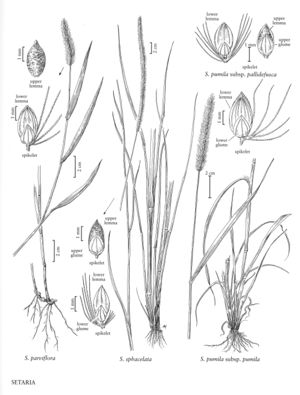Setaria sphacelata
Plants perennial; cespitose, rhizomatous, rhizomes stout. Culms 50-150 cm, flattened; nodes glabrous. Sheaths glabrous; blades 15-50 cm long, 4-10 mm wide, flat, rather lax. Panicles 5-25 cm long, 4-8 mm thick (excluding the bristles), densely spicate; bristles 5 or more, 3-6 mm, usually orange to purple. Spikelets 2.5-3 mm, elliptic-oblong. Lower glumes about as long as the spikelets; upper florets staminate; upper glumes Vi-A as long as the spikelets; lower lemmas equaling the upper lemmas; lower paleas equaling the upper paleas, broad; upper lemmas finely and transversely rugose; upper paleas similar to the upper lemmas. 2n = 36, 54.
Distribution
Calif., Fla., Ala., Miss.
Discussion
Setaria sphacelata is native to tropical Africa, but it has been found at a few scattered locations in the Flora region, often near a port. Clayton (1979) recognized five varieties of Setaria sphacelata. Those most likely to be introduced into the United States are Setaria sphace¬lata (Schumach.) Stapf & C.E. Hubb. var. sphacelata and S. sphacelata var. aurea (Hochst. ex A. Braun) Clayton, with var. aurea differing from var. sphacelata in having fibrous basal leaf sheaths and upper glumes that are often 3-veined.
Selected References
None.
